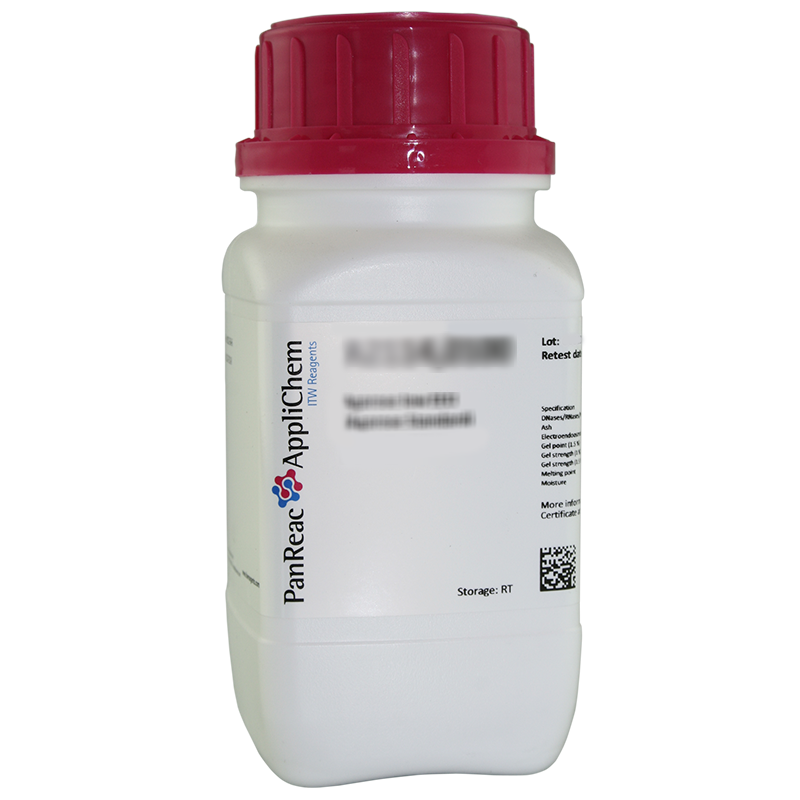Packs sizes (1)
| code | packaging size | price per unit | box price per unit | |
|---|---|---|---|---|
| Code & packaging | Price per piece | |||

|
code
A1688,0100
|
packaging size
100 g
|
price per unit
single
Request a quote
|
box price per unit
|
Technical data
- Solubility:
- 166.5 g/L (H2O)
- Physical Description:
- Solid
- Product Code:
- A1688
- Product Name:
- L-Alanine (Ph. Eur., USP) pure, pharma grade
- Headline Comment:
- • All amino acids from AppliChem are of non-animal origin!
- Specifications:
- Assay (titr., calc. on dried subst.): 98.5 - 101.0 %
α25°C/D; 10 %, 6 M HCl: +13.7° - +15.1°
Appearance of solution: passes test
Heavy metals (as Pb): max. 0.0015 %
Sulfated ash: max. 0.1 %
Loss on drying (3 h; 105°C): max. 0.2 %
Identity: passes test
α20°C/D; 10 %, HCl 250 g/L, calc. on dried subst.: +13.5° - +15.5°
pH (5 %; H2O; 25°C): 5.5 - 7.0
Ammonium: max. 0.02 %
Chloride: max. 0.02 %
Sulfate: max. 0.03 %
Fe: max. 0.001 %
Ninhydrin positive substances (HPLC)
Any ninhydrin-pos. Subst.: max. 0.1 %
Total impurities: max. 0.5 %
Ninhydrin positive substances (TLC)
Each individual impurity: max. 0.5 %
Total impurities: max. 2 %
- WGK:
- 1
- Storage:
- RT
- EINECS:
- 200-273-8
- CS:
- 29224985
Documents
Inquiry
Comments
Alanine, abbreviated as Ala or A, is a non-essential α-amino acid.enantiomers
Alanine is chiral, i.e. it occurs in two mirror-image forms, with L-alanine being a proteinogenic amino acid which, according to IUPAC, is also referred to as (S)-2-aminopropanoic acid or (S)-alanine. D-alanine [synonym: (R)-alanine] is found as a building block of murein, the basic substance of bacterial cell walls. There is also the non-proteinogenic β-alanine.
Story
L-Alanine was first isolated from silk fibroin in 1888.
Along with proline, alanine is one of the two amino acids that were first synthesized and not previously isolated from plant or animal material. Alanine was found by Adolph Strecker in 1850 when he actually wanted to synthesize lactic acid by reacting acetaldehyde with ammonia and hydrocyanic acid in the presence of hydrochloric acid, using the Strecker synthesis named after him. Strecker chose the name as a derivation of the term aldehyde, since he received the amino acid from said acetaldehyde. Alanine was first obtained from organic material in 1875 by Paul Schützenberger, when he split silk in an autoclave using barite and was able to identify a mixture of glycine and alanine. L-alanine accounts for 29.7% of the amino acids involved in building the protein chain.
synthesis
The industrial production of L-alanine starts from L-aspartic acid by splitting off the β-carboxy group in a biotechnological process. Racemic alanine obtained by the Strecker synthesis can be acetylated at the amino group and then subjected to resolution. Using L-aminoacylase, the acetyl group of L-N-acetylalanine is split off enantioselectively and L-alanine is formed, while D-N-acetylalanine is not hydrolyzed. The separation of L-alanine and D-N-acetylalanine is easy. When D-alanine is required, D-N-acetylalanine is hydrolyzed under acidic conditions, i. i.e. the acetyl group is split off. When there is no need for D-alanine, the D-N-acetylalanine obtained in the kinetic resolution is racemized by the action of acetic anhydride and recycled.
DL-alanine can also be synthesized from 2-bromopropanoic acid, but this method has no industrial importance.
In metabolism, L-alanine is synthesized by transamination from the end product of glycolysis, pyruvate. Bacteria obtain the required D-alanine from L-alanine using the enzyme alanine racemase (EC 5.1.1.1).
Characteristics
Alanine is usually present as an "inner salt" or zwitterion, the formation of which can be explained by the fact that the proton of the carboxy group migrates to the free electron pair of the nitrogen atom of the amino group:
At the physiological pH of 7.4, a large proportion of the alanine molecules are present as zwitterions. The isoelectric point of alanine is pH 6.1 and alanine reaches its lowest solubility in water because almost all alanine molecules exist as zwitterions. The solution has the lowest electrical conductivity at this point because zwitterions as a whole are uncharged.
physiological functions
In reversal of this synthesis reaction, it can also be broken down enzymatically to pyruvate (transamination). The basic carbon structure can be used again via pyruvate to build up glucose (gluconeogenesis) or be completely broken down via the citric acid cycle to generate energy. The oxidative deamination of L-alanine to pyruvate and ammonia, catalyzed by the enzyme alanine dehydrogenase, represents a further degradation possibility; it shows in an exemplary manner how part of the amino acid metabolism is linked to the carbohydrate metabolism.
L-alanine is a non-essential amino acid for humans, so it can be produced biosynthetically by the human metabolism.
Alanine occurs - in addition to other amino acids such. B. leucine and glutamic acid - preferentially in α-helices of proteins. These amino acids favor the formation of this secondary structural element and are therefore also referred to as helix formers.
use
L-alanine is a component of infusion solutions for parenteral nutrition and dietetics.
The two enantiomers of alanine, provided with a protective group, are often used for the synthesis of peptides and proteins. Furthermore, L- or D-alanine is also used as a starting material in stereoselective synthesis.





